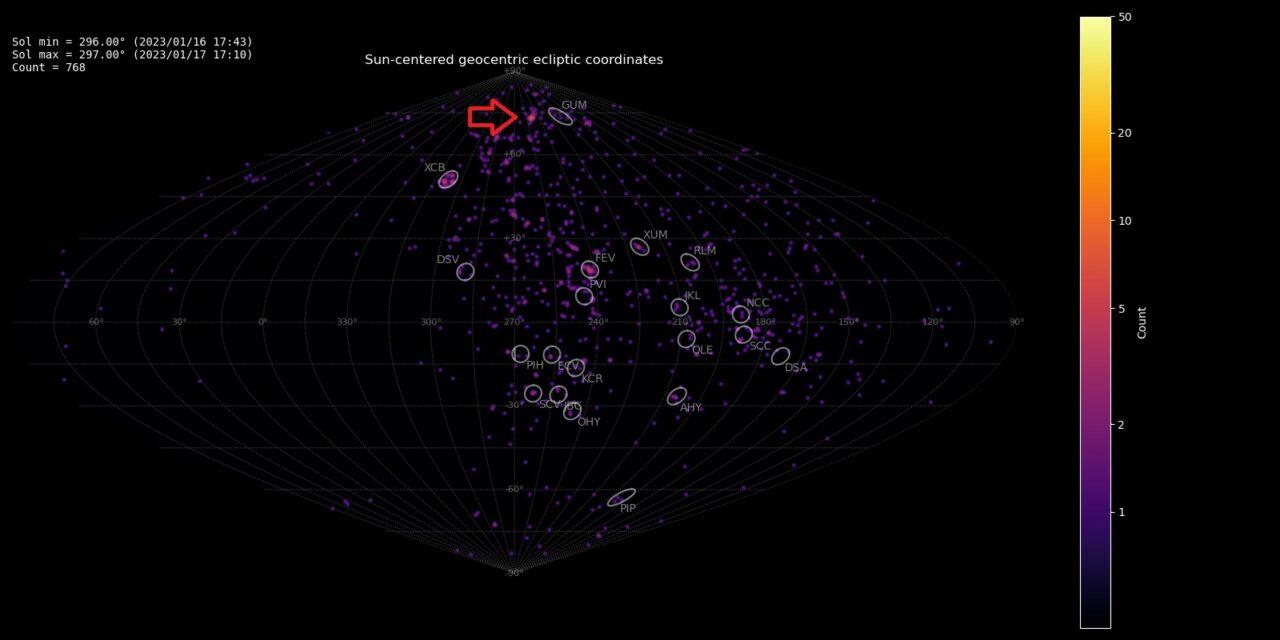By Damir Šegon, Denis Vida and Paul Roggemans
Abstract: A new meteor shower on a JFC-type orbit has been detected in 2023 by the Global Meteor Network during the time interval 295.0° < λʘ < 299.0° (January 15–19) from a radiant at R.A. = 235° and Decl.= +61° with a geocentric velocity of 32.8 km/s. This radiant position is east from the known gamma-Ursae Minorids (GUM#0404) meteor shower which has its strongest activity when the new shower activity ends. The new meteor shower has been listed in the Working List of Meteor Showers under the temporary identification M2023-D2.
Introduction
The Global Meteor Network radiant map for January 16–17, 2023 (Figure 1) showed a remarkable concentration at a distinct distance east from the known gamma-Ursae Minorids (GUM#0404). This possible new shower appears earlier in time than the gamma-Ursae Minorids and disappears once GUM reaches more significant activity. This is also visible on the radiant plot obtained by CAMS where a concentration of unidentified radiants appears east from the early GUM-radiants well in advance before the gamma-Ursae Minorids appear as a strong concentration on the map. However, most of the radiants shown on the CAMS map (Figure 11) are in fact taken from the Global Meteor Network data and display the same radiants.
Meteor shower search methodology
Once a group of meteoroid orbits has been detected on GMN plots, the method used for the determination of the shower parameters consists of the following steps.
At first, radiant positions are being roughly estimated in Sun-centered geocentric ecliptic coordinates λg – λʘ, βg. Also, the solar longitude range during which the radiant can be seen on plots, as well as a rough radius of radiant dispersion are determined. The radius is usually taken to be a couple of degrees larger than the actual size in order to cover all contributing radiants.
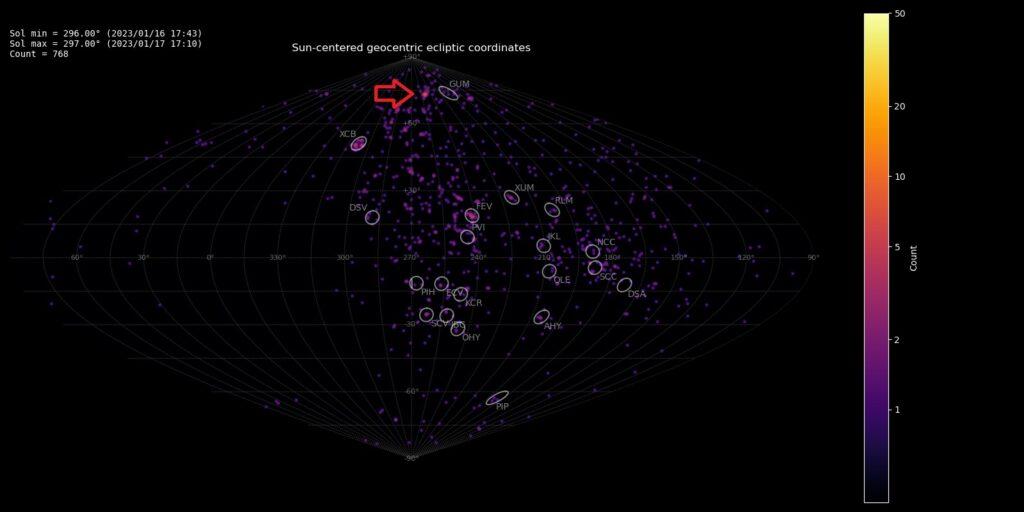
Figure 1 – Radiant plot of the Global Meteor Network data for 2023 January 16–17 in Sun-centered geocentric ecliptic coordinates. The new radiant is visible left of the GUM radiant and is marked by a red arrow.
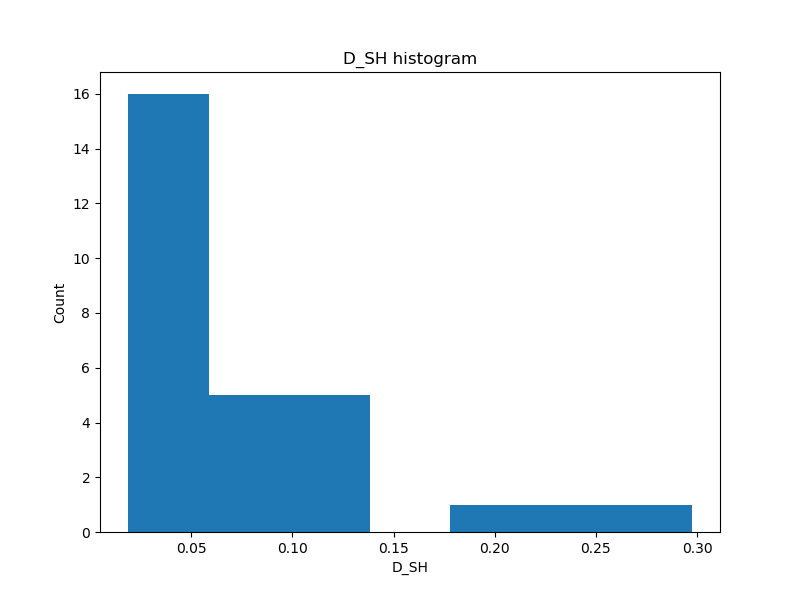
Figure 2 – Histogram of the distribution of the values of the DSH criterion valid for the first mean orbit estimate.
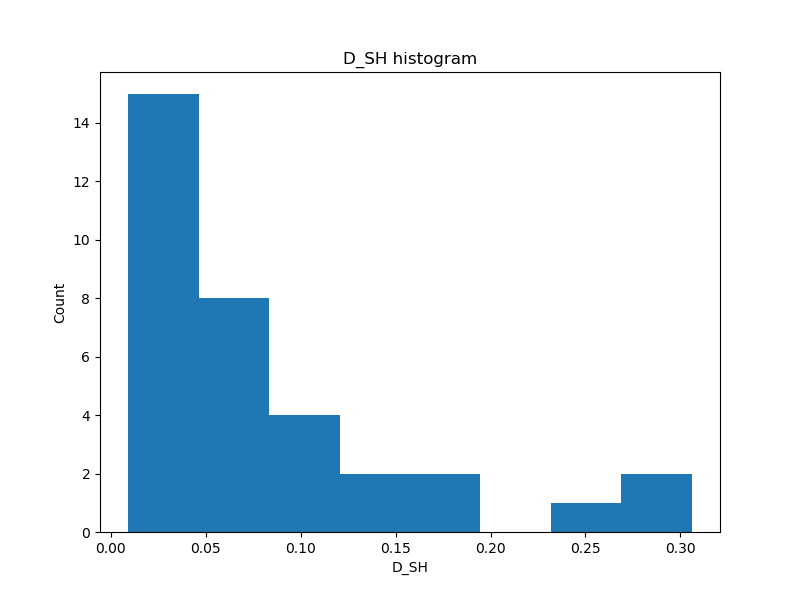
Figure 3 – Histogram of the distribution of values of the DSH criterion valid for the final mean orbit.
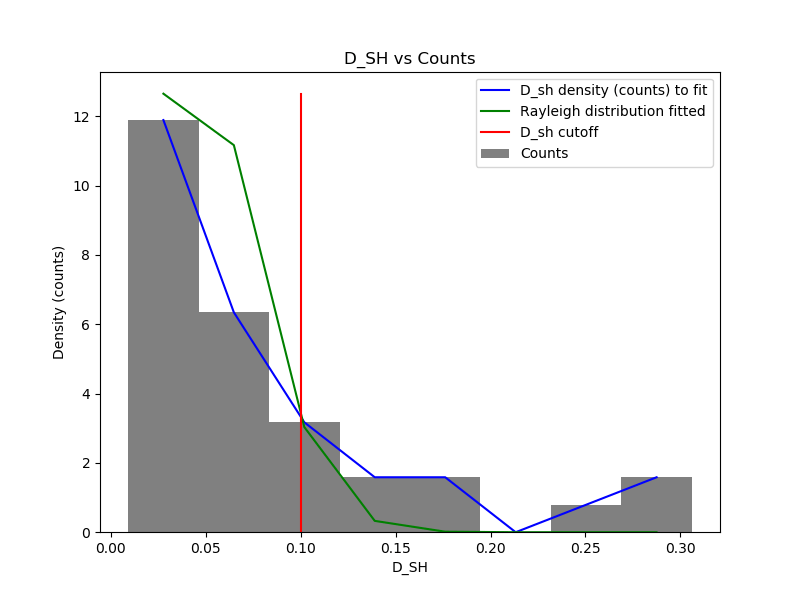
Figure 4 – Rayleigh distribution fit and DSH cutoff.
The numeric average orbit of the radiants that satisfy the criteria is computed and we calculate the Southworth and Hawkins (1963) D-criterion for each selected orbit and the reference mean orbit. The resulting distribution of D-criteria plotted as a histogram (Figure 2) allows us to select the histogram bin containing most meteors. This bin is often not the bin with the smallest D-criterion value, indicating that it follows a Rayleigh distribution.
Next, we recompute the mean orbit using only these core orbits and the updated D-criterion distribution is shown in Figure 3. We then fit a Rayleigh distribution to the computed offsets and choose a D-criterion cutoff value at the 95th percentile (Figure 4). In case the fit fails, we estimate the D-criteria cutoff in a manual way, by picking the smallest D-criteria value covering the left part of the distribution down to local minima count. The Raileigh distribution may not be the correct choice of the D-criteria distribution for all cases, but the estimated D-criteria cutoff in this case shows that the remaining non-shower orbits are not affected by the extraction from the dataset of new shower ones (see Figure 5). This D-criteria cutoff is then used to isolate only orbits satisfying it, and from this set of orbits the mean orbital parameters and radiant positions are calculated using the method of Jopek et al. (2006). On the radiant and Π – i plots, circles represent the part of the radiants we want to emphasize while pale diamonds represent alternative ones, both solar longitude color-coded. Dimensions of circles/diamonds represent the estimated magnitudes (smallest being faintest), while error bars represent a 2-sigma error of the plotted parameter.
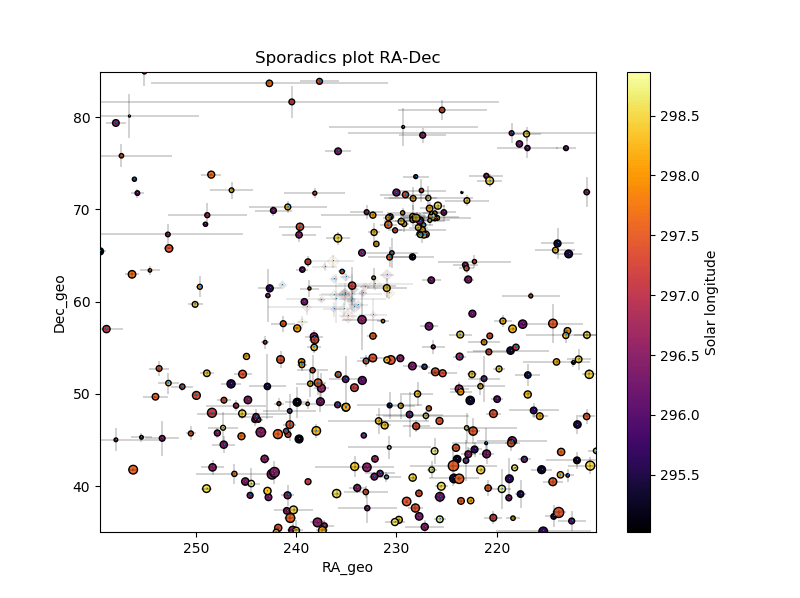
Figure 5 – All radiants in geocentric equatorial coordinates during the shower activity. The gray crosses are the new shower radiants, you can see the GUM radiants in the upper right.
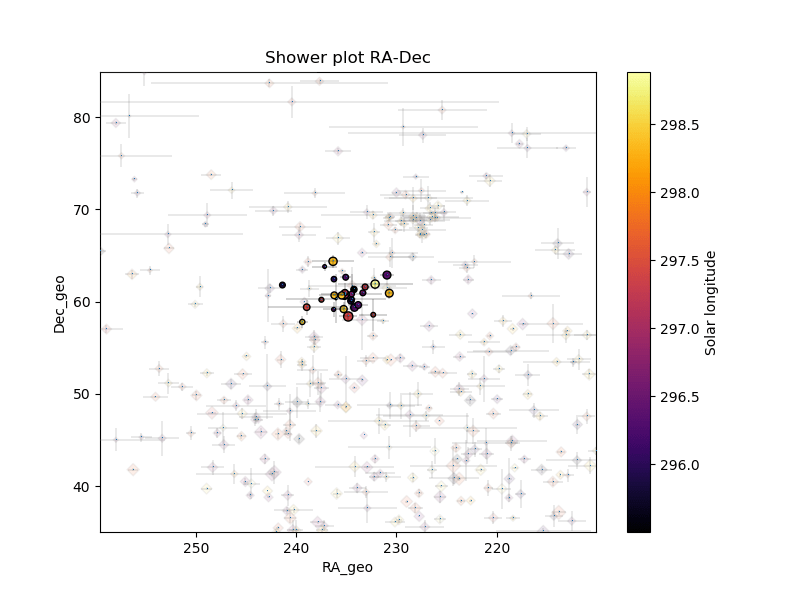
Figure 6 – The reverse of Figure 5, where the background radiants are now grayed out, all radiants in geocentric equatorial coordinates. The GUM shower radiants may be clearly seen as a separate group of orbits at their expected radiant positions (up and right from the new shower).
The shower radiants are compared to the sporadic background in Figures 5 and 6. The concentration of the orbits is also shown in the diagram of the inclination i against longitude of perihelion Π (Figure 7). The activity period appears within the time interval 295.0° < λʘ < 299.0° (Figure 8).
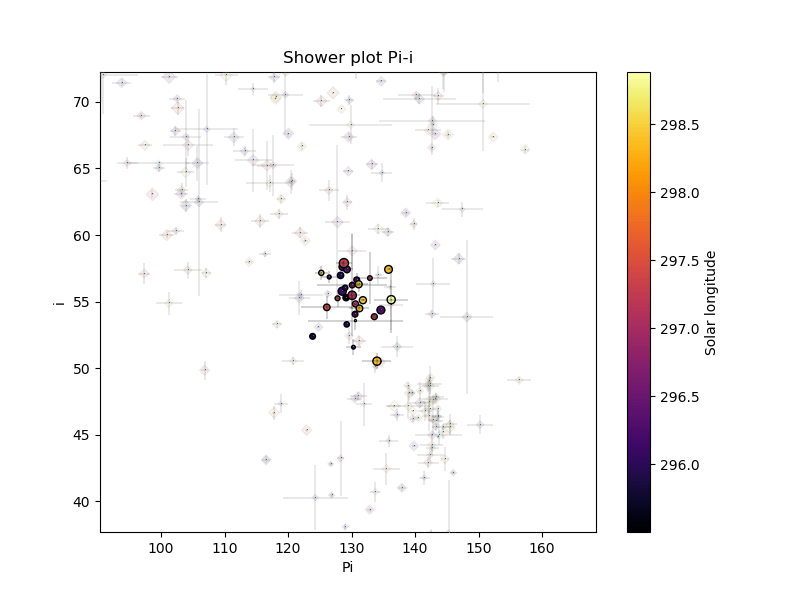
Figure 7 – The diagram of the inclination i against longitude of perihelion Π. The GUM shower radiants may be clearly seen as a separate group of orbits (down and right from the new shower).
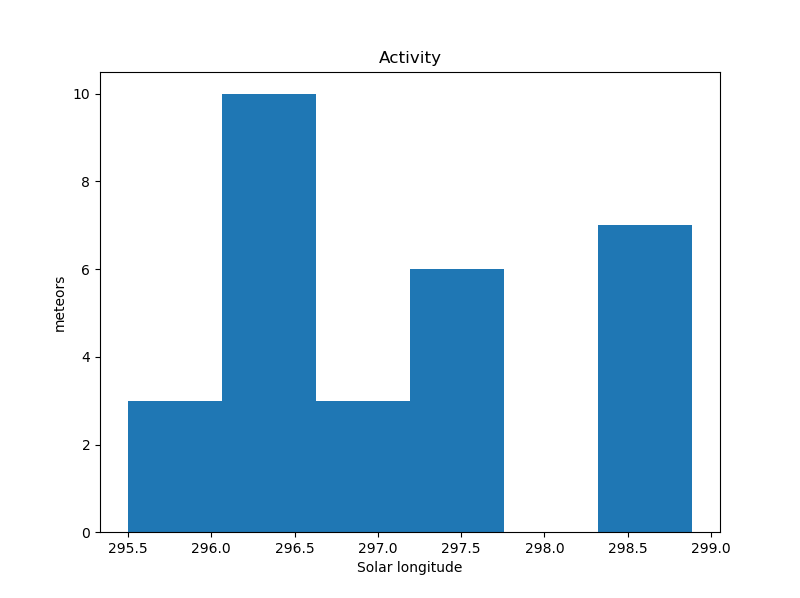
Figure 8 – The activity period with the number of orbits identified as new shower members.
New shower or existing shower?
Before making claims that the detected activity qualifies to be listed as a new meteor shower, the known existing meteor showers active around this time from this part of the sky have to be checked. The first suspect candidate is the afore mentioned gamma-Ursae Minorid meteor shower. In equatorial geocentric coordinates, the radiant concentrations appear as close neighbors as well as in Sun- centered ecliptic geocentric coordinates. As the new shower activity appears east and earlier than the bulk of the GUM-activity, the off-set in radiant positions cannot be explained by radiant drift. The Tisserand relative to Jupiter proves both are JFC-type orbits (Table 1). The orbits differ mainly by ~7° in inclination and ~12° in longitude of perihelion.
Further verification of the IAU MDC Working List of Meteor Showers (Jenniskens et al., 2020; Jopek and Kaňuchová, 2014; 2017; Jopek and Jenniskens, 2011; Neslušan et al., 2020) reveals two more candidate meteoroid streams, about 10 days earlier in time from a radiant position close to that of the possible new meteor shower, in equatorial as well as in Sun-centered ecliptic coordinates. However, these two showers appear to be an erroneous duplicated entry, listed as the January eta-Draconids (JED#1099) and January iota-Draconids (JID#1107) by Jenniskens (2022). Both orbits have a Tisserand value relative to Jupiter typical for long period comet type orbits with a distinct different eccentricity e compared to the possible new shower. The longitude of perihelion differs by ~15°. The different nature of this orbit compared to the one of the possible new shower, which has a JFC-type orbit, excludes that JED or JID represent the same meteoroid stream.
Table 1 – Known neighboring showers, gamma-Ursae Minorids (GUM#0404, Shiba, 2022), January eta-Draconids (JED#1099), Jenniskens, 2022), January iota-Draconids (JID#1107), Jenniskens, 2022) and the new meteor shower.
| GUM | JED | JID | New | |
| λʘ (°) | 299.7 | 287.6 | 286.9 | 296.3 |
| λʘb (°) | 296.2 | – | – | 295.5 |
| λʘe (°) | 304.9 | – | – | 298.9 |
| αg (°) | 229.0 | 237.3 | 236.3 | 235.2 |
| δg (°) | +67.7 | +62.6 | +62.3 | +60.7 |
| Δαg (°) | 0.99 | – | – | – |
| Δδg (°) | –0.70 | – | – | – |
| vg (km/s) | 29.4 | 37.3 | 37.3 | 32.8 |
| λ (°) | 157.1 | 180.5 | 180.6 | 184.2 |
| λg – λʘ (°) | 217.4 | 252.9 | 253.7 | 247.1 |
| βg (°) | +74.3 | +75.6 | +75.1 | +73.7 |
| a (A.U.) | 2.79 | 25.6 | 19.4 | 2.73 |
| q (A.U.) | 0.952 | 0.979 | 0.979 | 0.973 |
| e | 0.659 | 0.962 | 0.950 | 0.644 |
| i (°) | 48.0 | 59.5 | 59.6 | 55.3 |
| ω (°) | 203.1 | 187.4 | 187.7 | 193.1 |
| Ω (°) | 299.7 | 287.5 | 286.9 | 297.1 |
| Π (°) | 142.8 | 114.9 | 114.6 | 130.2 |
| Tj | 2.60 | 0.82 | 0.88 | 2.54 |
| N | 60 | 28 | 21 | 29 |
Another search method
Another method has been applied to check this new meteor shower discovery. The starting point here can be any visually spotted concentration of radiant points or any other indication for the occurrence of similar orbits. The method has been described before (Roggemans et al., 2019). The main difference with the method described in Section 2 is that three different discrimination criteria are combined in order to have only those orbits which fit different criteria. Instead of using a cutoff value for the D-criteria these values are considered in different classes with different thresholds of similarity. Depending on the dispersion and the type of orbits, the most appropriate threshold of similarity is selected to locate the best fitting mean orbit as a result of an iterative procedure.
Applying this search method, the same orbits are found as with the higher described method. Figure 9 shows the radiants in Sun-centered geocentric ecliptic coordinates with the sporadic background (black), the gamma-Ursae Minorids (blue) and two similarity classes for the new shower (yellow and red). The average radiant of the new shower is east of that of the gamma-Ursae Minorid radiants.
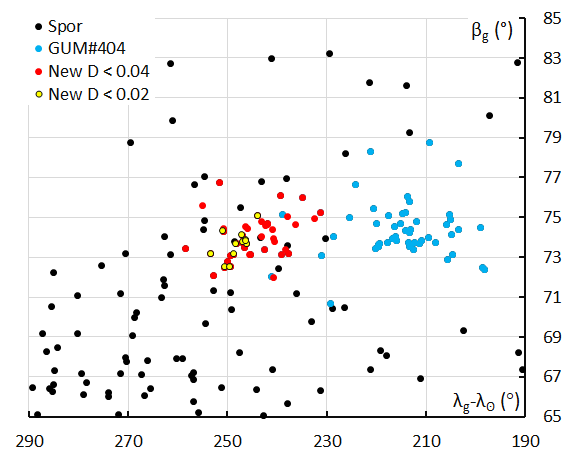
Figure 9 – Close up of the Sun-centered ecliptic geocentric coordinates for the possible new shower and the orbits identified as gamma-Ursae Minorids.
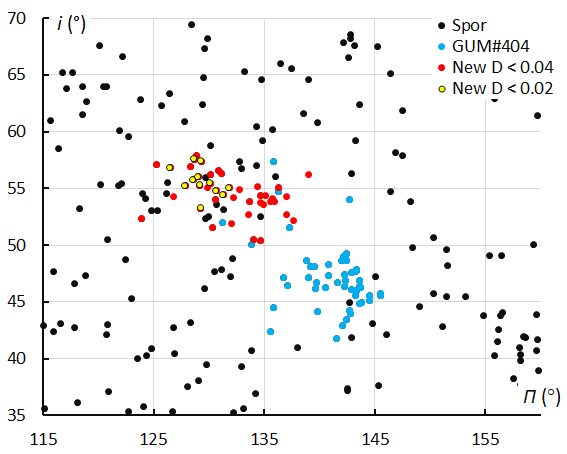
Figure 10 – Diagram of the inclination i against the longitude of perihelion Π for the new shower and the gamma-Ursae Minorids.
The offset in the concentration of orbits is also very obvious in the diagram showing the inclination i against the longitude of perihelion Π (Figure 10). The 12 best fitting orbits within the interval 295.0° < λʘ < 299.0°, according to this method yield a mean orbit which is in perfect agreement with the results presented in Table 1.
- a = 2.75 AU
- q = 0.974 AU
- e = 0.6465
- i = 55.6°
- Ω = 296.80°
- ω = 192.52°
Comparing older data and other datasets
Looking up past years orbit data for Global Meteor Network, we find only 16 similar orbits with DSH < 0.1 and DD < 0.04 for the period 2019 to 2022. Checking the CAMS data for 2011–2016 we also find 16 similar orbits with DSH < 0.1 and DD < 0.04. The SonotaCo data for 2007–2021 yield 12 orbits with DSH < 0.1 and DD < 0.04. And EDMOND data for 2006–2016 had only 6 similar orbits with DSH < 0.1 and DD < 0.04. 2023 appears to be the first year with noticeable activity for this new shower.
As mentioned in the introduction, the new shower appears also as a group of unidentified radiants on the CAMS map for January 16–17 (Figure 11). However, this data consists meanly of GMN data and it is not possible to select only CAMS data in this display.

Figure 11 – Radiant plot for CAMS on 2023 January 17. The radiant concentration is indicated with a red arrow.
Conclusion
A new meteor shower radiant has been discovered in Global Meteor Network data around 2023 January 16–17 with a radiant close but still distinct from the known gamma-Ursae Minorids. A mean orbit could be established based on 29 orbits. The new shower and the GUM orbits being of the same type and relatively close apart in space, may be somehow related and belong to a small complex of common origin.
The new meteor shower has been reported to the IAU and has been listed in the Working List of Meteor Showers under the temporary identification M2023-D2.
Acknowledgment
The authors thank all people who support the Global Meteor Network by contributing meteor camera data or in any other way to help monitoring meteor activity around the clock worldwide. The Global Meteor Network results were obtained thanks to the efforts of the following volunteers: Richard Abraham, Victor Acciari, Rob Agar, Jonathan Alexis Valdez Aguilar, Salvador Aguirre, Yohsuke Akamatsu, David Akerman, Daknam Al-Ahmadi, Jamie Allen, Edison José Felipe Pérezgómez Álvarez, Alexandre Alves, Don Anderson, Željko Andreić, Martyn Andrews, Miguel Diaz Angel, Enrique Arce, Georges Attard, David Attreed, Chris Baddiley, David Bailey, Erwin van Ballegoij, Roger Banks, Hamish Barker, Jean-Philippe Barrilliot, Alejandro Barriuso, Amy Barron, Ricky Bassom, Richard Bassom, Creina Beaman, Alan Beech, Dennis Behan, Ehud Behar, Josip Belas, Alex Bell, Florent Benoit, Denis Bergeron, Serge Bergeron, Jorge Augusto Acosta Bermúdez, Steve Berry, Adrian Bigland, Frantisek Bilek, Jim Blackhurst, Chris Blake, Thomas Blog, Arie Blumenzweig, Ventsislav Bodakov, Claude Boivin, Robin Boivin, Bruno Bonicontro, Mia Boothroyd, Ludger Börgerding, Fabricio Borges, Ubiratan Borges, Steve Bosley, Dorian Božičević, David Brash, Mike Breimann, Stuart Brett, Ed Breuer, Martin Breukers, John W. Briggs, Gareth Brown, Peter G. Brown, Nial Bruce, Laurent Brunetto, Nigel Bubb, Tim Burgess, Jason Burns, Jon Bursey, Yong-Ik Byun, Sylvain Cadieux, Dino Čaljkušić, Peter Campbell-Burns, Andrew Campbell-Laing, Pablo Canedo, Seppe Canonaco, Jose Carballada, Rolf Carstens, Steve Carter, David Castledine, Gilton Cavallini, Andrew Challis, Brian Chapman, Jason Charles, Jim Cheetham, Zhuoyang Chen, Matt Cheselka, Ivica Ćiković, Tim Claydon, Trevor Clifton, Fiona Cole, Manel Colldecarrera, Michael Cook, Bill Cooke, Simon Cooke-Willis, Christopher Coomber, Brendan Cooney, Edward Cooper, Jamie Cooper, Andrew Cooper, Tim Cooper, Bernard Côté, Paul Cox, Jim Critchley, Richard Croy, Llewellyn Cupido, Christopher Curtis, Chris Dakin, Fernando Dall’Igna, James Davenport, Peter Davis, Richard Davis, Pedro Augusto Hay Day, Steve Dearden, Christophe Demeautis, Bart Dessoy, Pat Devine, Paul Dickinson, Ivo Dijan, Tammo Jan Dijkema, Pieter Dijkema, Luciano Miguel Diniz, Marcelo Domingues, Jürgen Dörr, Lucia Dowling, Stacey Downton, Stewart Doyle, Zoran Dragić, Iain Drea, John Drummond, Daniel Duarte, Igor Duchaj, Jean-Paul Dumoulin, Garry Dymond, Jonathan Eames, Robin Earl, Howard Edin, Raoul van Eijndhoven, Ollie Eisman, Carl Elkins, Peter Eschman, Bob Evans, Nigel Evans, Bev M. Ewen-Smith, Mark Fairfax, James Farrar, Seraphin Feller, Andres Fernandez, Louw Ferreira, Andrew Fiamingo, Barry Findley, Rick Fischer, Richard Fleet, Murray Forbes, Jim Fordice, Ange Fox, Kyle Francis, Patrick Franks, Ryan Frazer, Stefan Frei, Gustav Frisholm, Pierre Gamache, José María García, Enrique Chávez Garcilazo, Ivan Gašparić, Mark Gatehouse, Chris George, Megan Gialluca, Kevin Gibbs-Wragge, Marc Corretgé Gilart, Lachlan Gilbert, Jim Gilbert, Jason Gill, Philip Gladstone, Uwe Glässner, Roel Gloudemans, Tim Gloudemans, Chuck Goldsmith, Hugo González, Brenda Goodwill, Nikola Gotovac, Ian Enting Graham, Neil Graham, Colin Graham, Pete Graham, Phillip Wilhelm Maximilian Grammerstorf, Sam Green, Bob Greschke, Stephen Grimes, Daniel J. Grinkevich, Larry Groom, Dominique Guiot, Tioga Gulon, Margareta Gumilar, Peter Gural, Nikolay Gusev, Kees Habraken, Bernard Hagen, Alex Haislip, John Hale, Peter Hallett, Graeme Hanigan, Erwin Harkink, Ed Harman, Marián Harnádek, Ryan Harper, David Hatton, Jason van Hattum, Tim Havens, Mark Haworth, Paul Haworth, Richard Hayler, Andrew Heath, Paul Heelis, Sam Hemmelgarn, Igor Henrique, Rick Hewett, Lee Hill, Nicholas Hill, Don Hladiuk, Alex Hodge, Simon Holbeche, Jeff Holmes, Lisa Holstein, Steve Homer, Anthony Hopkinson, Nick Howarth, Matthew Howarth, Jeff Huddle, Gordon Hudson, Bob Hufnagel, Roslina Hussain, Mike Hutchings, Jan Hykel, Roland Idaczyk, Anatoly Ijon, Russell Jackson, Jean-Marie Jacquart, Jost Jahn, Tihomir Jakopčić, Nick James, Chris James, Rick James, Phil James, Ken Jamrogowicz, Ilya Jankowsky, Peter Jaquiery, Alex Jeffery, Klaas Jobse, Richard Johnston, Kath Johnston, Dave Jones, Fernando Jordan, Romulo Jose, Vladimir Jovanović, Ron James Jr, Alfredo Dal’ Ava Júnior, Jocimar Justino, Javor Kac, Richard Kacerek, Milan Kalina, Jonathon Kambulow, Steve Kaufman, Scott Kaufmann, Paul Kavanagh, Ioannis Kedros, Peter Kent, Jürgen Ketterer, Alex Kichev, Harri Kiiskinen, Jean-Baptiste Kikwaya, Sebastian Klier, Dan Klinglesmith, John Kmetz, Zoran Knez, Danko Kočiš, Korado Korlević, Stanislav Korotkiy, Bela Szomi Kralj, Josip Krpan, Zbigniew Krzeminski, Reinhard Kühn, Patrik Kukić, Remi Lacasse, Gaétan Laflamme, Steve Lamb, Hervé Lamy, Stuart Land, Jean Francois Larouche, Ian Lauwerys, Peter Lee, Hartmut Leiting, Damien Lemay, Guy Létourneau, David Leurquin, Gareth Lloyd, Rob de Corday Long, Robert Longbottom, Jose Galindo Lopez, Eric Lopez, Paul Ludick, José Martin Luis, Pete Lynch, Frank Lyter, Anton Macan, Jonathan Mackey, John Maclean, Igor Macuka, Nawaz Mahomed, Simon Maidment, Mirjana Malarić, Nedeljko Mandić, Alain Marin, Bob Marshall, Colin Marshall, Gavin Martin, Andrei Marukhno, Keith Maslin, Nicola Masseroni, Bob Massey, Jacques Masson, Damir Matković, Filip Matković, Dougal Matthews, Alan Maunder, Michael Mazur, Sergio Mazzi, Stuart McAndrew, Lorna McCalman, Alex McConahay, Mason McCormack, Charlie McCormack, Robert McCoy, Jamie McCulloch, Vincent McDermott, Tommy McEwan, Mark McIntyre, Peter McKellar, Simon McMillan, Damien McNamara, Peter Meadows, Edgar Mendes Merizio, Aleksandar Merlak, Horst Meyerdierks, Filip Mezak, Pierre-Michael Micaletti, Greg Michael, Matej Mihelčić, Simon Minnican, Wullie Mitchell, Georgi Momchilov, Dean Moore, Edson Valencia Morales, Lubomir Moravek, Nelson Moreira, Kevin Morgan, Roger Morin, Nick Moskovitz, Daniela Cardozo Mourão, Dave Mowbray, Andrew Moyle, Gene Mroz, Muhammad Luqmanul Hakim Muharam, Adam Mullins, Juan Luis Muñoz, Brian Murphy, Carl Mustoe, Przemek Nagański, Jean-Louis Naudin, Damjan Nemarnik, Attila Nemes, Dave Newbury, Colin Nichols, Tommy B. Nielsen, Nick Norman, Philip Norton, Zoran Novak, Gareth Oakey, Washington Oliveira, Jorge Oliveira, Angélica López Olmos, Jamie Olver, Christine Ord, Nigel Owen, Michael O’Connell, Dylan O’Donnell, Thiago Paes, Carl Panter, Neil Papworth, Filip Parag, Gary Parker, Ian Parker, Simon Parsons, Ian Pass, Lovro Pavletić, Igor Pavletić, Richard Payne, Pierre-Yves Pechart, Holger Pedersen, Eduardo Fernandez Del Peloso, William Perkin, Heather Petelo, Enrico Pettarin, Alan Pevec, Mark Phillips, Alan Pickwick, Anthony Pitt, Patrick Poitevin, Tim Polfliet, Renato Poltronieri, Pierre de Ponthière, Callum Potter, Derek Poulton, Janusz Powazki, Aled Powell, Alex Pratt, Miguel Preciado, David Price, Nick Primavesi, Paul Prouse, Paul Pugh, Chuck Pullen, Terry Pundiak, Anzhari Purnomo, Lev Pustil’Nik, Dan Pye, Nick Quinn, Chris Ramsay, David Rankin, Steve Rau, Mike Read, Dustin Rego, Chris Reichelt, Danijel Reponj, Fernando Requena, Maciej Reszelsk, Jessica Richards, Ewan Richardson, Terry Richardson, Martin Richmond-Hardy, Mark Robbins, Martin Robinson, David Robinson, Heriton Rocha, Paul Roche, Herve Roche, Paul Roggemans, Adriana Roggemans, Alex Roig, David Rollinson, Marthinus Roos, Andre Rousseau, Brian Rowe, Jim Rowe, Nicholas Ruffier, Nick Russel, Janis Russell, Dmitrii Rychkov, Robert Saint-Jean, Michel Saint-Laurent, Jason Sanders, Clive Sanders, Ivan Sardelić, Simon Saunders, Rob Saunders, John Savage, Lawrence Saville, Vasilii Savtchenko, Philippe Schaak, William Schauff, Ansgar Schmidt, Thomas Schmiereck, James Scott, Geoff Scott, Yfore Scott, Jim Seargeant, Damir Šegon, Marko Šegon, Jay Shaffer, Steven Shanks, Mike Shaw, Jamie Shepherd, Angel Sierra, Ivo Silvestri, François Simard, Terry Simmich, Noah Simmonds, Murray Singleton, Nikos Sioulas, Ivica Skokić, Zané Smit, Ian A. Smith, Dave Smith, Ned Smith, Tracey Snelus, Germano Soru, Warley Souza, Mark Spink, Denis St-Gelais, James Stanley, Radim Stano, Laurie Stanton, Robert D. Steele, Yuri Stepanychev, Graham Stevens, Thomas Stevenson, Richard Stevenson, Peter Stewart, William Stewart, Paul Stewart, Con Stoitsis, Andrea Storani, Andy Stott, David Strawford, Mark Suhovecky, Claude Surprenant, Rajko Sušanj, Ciaran Tangney, René Tardif, Jeremy Taylor, David Taylor, Yakov Tchenak, Jacqui Thompson, Murray Thompson, John Thurmond, Steven Tilley, Stanislav Tkachenko, Christopher Tofts, Steve Tonkin, Sarah Tonorio, Eric Toops, Torcuill Torrance, Peter Triffitt, Steve Trone, Wenceslao Trujillo, John Tuckett, Sofia Ulrich, Myron Valenta, Jean Vallieres, Paraksh Vankawala, Neville Vann, Robert Veronneau, Marco Verstraaten, Arie Verveer, Jochen Vollsted, Predrag Vukovic, Aden Walker, Martin Walker, Bill Wallace, John Waller, Jacques Walliang, Didier Walliang, Christian Wanlin, Tom Warner, Andrew Washington, Neil Waters, Steve Welch, Tobias Westphal, Tosh White, Jonathan Whiting, Alexander Wiedekind-Klein, John Wildridge, Ian Williams, Mark Williams, Guy Williamson, Graham Winstanley, Urs Wirthmueller, Jan Wisniewski, Bill Witte, Jeff Wood, Martin Woodward, Jonathan Wyatt, Anton Yanishevskiy, Penko Yordanov, Justin Zani, Stephane Zanoni, Bob Zarnke, Christof Zink, Pető Zsolt, Dario Zubović, Marcelo Zurita, Asociación de Astronomía de Marina Alta, Costa Blanca Astronomical Society, Perth Observatory Volunteer Group, Royal Astronomical Society of Canada Calgary Centre (list established 2 May 2023).
References
Drummond J. D. (1981). “A test of comet and meteor shower associations”. Icarus, 45, 545–553.
Jenniskens P., Jopek T. J., Janches D., Hajduková M., Kokhirova G. I., Rudawska R. (2020). “On removing showers from the IAU Working List of Meteor Showers”. Planetary and Space Science, 182, article id. 104821.
Jenniskens P. (2022). Submitted.
Jopek T. J., Rudawska R. and Pretka-Ziomek H. (2006). “Calculation of the mean orbit of a meteoroid stream”. Monthly Notices of the Royal Astronomical Society, 371, 1367–1372.
Jopek T. J., Jenniskens P. M. (2011). “The Working Group on Meteor Showers Nomenclature: A History, Current Status and a Call for Contributions”. In, W.J. Cooke, D.E. Moser, B.F. Hardin, and D. Janches, editors, Meteoroids: The Smallest Solar System Bodies, Proceedings of the Meteoroids Conference held in Breckenridge, Colorado, USA, May 24-28, 2010. NASA/CP-2011-216469, pages 7–13.
Jopek T. J., Kaňuchová Z. (2014). “Current status of the~IAU MDC Meteor Showers Database”. In, T.J. Jopek, F.J.M. Rietmeijer, J. Watanabe, I.P. Williams, editors, Meteoroids 2013 Proceedings of the Astronomical Conference held at A.M. University, Poznan, Poland, Aug. 26-30, 2013, A.M. University Press, pages 353–364.
Jopek T. J., Kaňuchová Z. (2017). “IAU Meteor Data Center-the shower database: A status report”. Planetary and Space Science, 143, 3–6.
Neslušan L., Poručan V., Svoreň J., Jakubík M. (2020). “On the new design othe IAU MDC portal”. WGN, Journal of the International Meteor Organization, 48, 168–169.
Roggemans P., Johannink C. and Campbell-Burns P. (2019a). “October Ursae Majorids (OCU#333)”. eMetN, 4, 55–64.
Shiba Y. (2022). “Jupiter Family Meteor Showers by SonotaCo Network Observations”. WGN, Journal of the International Meteor Organization, 50, 38–61.
Southworth R. B. and Hawkins G. S. (1963). “Statistics of meteor streams”. Smithsonian Contributions to Astrophysics, 7, 261–285.

